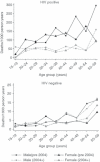The impact of antiretroviral treatment on mortality trends of HIV-positive adults in rural Uganda: a longitudinal population-based study, 1999-2009
- PMID: 22943381
- PMCID: PMC3443388
- DOI: 10.1111/j.1365-3156.2012.02841.x
The impact of antiretroviral treatment on mortality trends of HIV-positive adults in rural Uganda: a longitudinal population-based study, 1999-2009
Abstract
Objective: To investigate trends in all-cause adult mortality after the roll-out of an antiretroviral therapy (ART) programme in rural Uganda.
Methods: Longitudinal population-based cohort study of approximately 20,000 residents in rural Uganda. Mortality in adults aged 15-59 years was determined for the 5-year period (1999-2003) before introduction of ART in January 2004 and for the 5-year period afterwards. Poisson regression was used to estimate mortality rate ratios (RRs) for the period before ART, 1 year after ART introduction (from January 2004 to January 2005) and more than 1 year after ART introduction. Trends in mortality were analysed by HIV status, age and sex.
Results: Before ART became available, the mortality rate (deaths per 1000 person-years) was 4.0 (95% CI = 3.3-4.8) among HIV-negative individuals and 116.4 (95% CI = 101.9-133.0) among HIV-positive individuals. During the period January 2004-end November 2009, 279 individuals accessed ART. In the year after ART was introduced, the mortality rate (deaths per 1000 person-years) among HIV-negative individuals did not change significantly (adjusted RR = 0.95, 95% CI = 0.61-1.47), but among HIV-positive individuals dropped by 25% to 87.4 (adjusted RR = 0.75, 95% CI = 0.53-1.06). In the period 2005-2009, the mortality rate (deaths per 1000 person-years) among HIV-positive individuals fell further to 39.9 (adjusted RR = 0.33, 95% CI = 0.26-0.43). The effect was greatest among individuals aged 30-44 years, and trends were similar in men and women.
Conclusion: The substantially reduced mortality rate among HIV-positive individuals after ART roll-out lends further support to the intensification of efforts to ensure universal access to ART.
© 2012 Blackwell Publishing Ltd.
Figures


References
-
- Floyd S, Molesworth A, Dube A, et al. Population-level reduction in adult mortality after extension of free anti-retroviral therapy provision into rural areas in Northern Malawi. PLoS ONE. 2010;5:e13499. doi: 10.1371/journal.pone.0013499. - DOI - PMC - PubMed
-
- Garnett GP, Baggaley RF. Treating our way out of the HIV pandemic: could we, would we, should we? Lancet. 2009;373:9–11. - PubMed
MeSH terms
Substances
Grants and funding
LinkOut - more resources
Full Text Sources
Medical

